Allard For Sale
/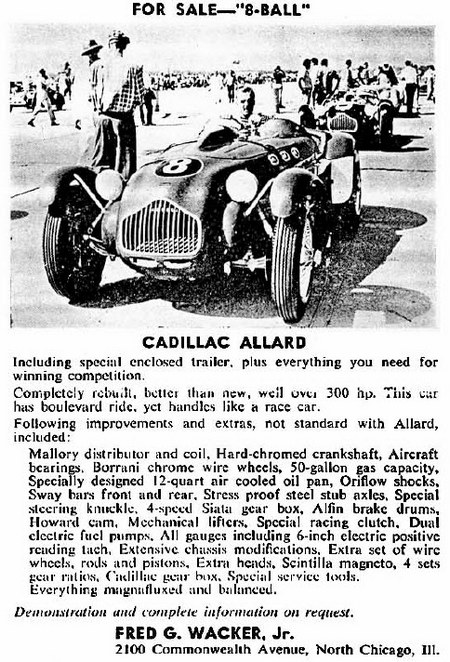
From the SCCA National Newsletter #8, September, 1953
If you find a story below interesting, please click the "Like" button...Thank You!

From the SCCA National Newsletter #8, September, 1953
We were fortunate enough to recently receive the donation of an alloy Allard Intake Manifold (thank you!) and we thought you might like to know the back story behind these unique manifolds…
In the late 40’s, Allard was struggling to make their Ford flatheads more powerful. The stock single carb intake manifold was pathetic and Sydney knew there were several alternatives available in the US. Unfortunately Post War England was very protectionist as it tried to rebound from the war. Basically nothing could be imported into the country, which meant no American speed parts could be sold in the UK.
If you’ve read the Tom Lush’s definitive Allard book, you may recall that in 1948, Reg Canham took an Allard M type to the US and went on a cross country tour towing a caravan to promote the Allard Motor Company (a pre-cursor to GM’s motor-rama). Not much is known about this trip, but we do know that Reg stopped in Los Angeles, where he met a number of hot rodders. One of the people he met was Eddie Meyer who operated a speed shop dedicated to extracting more power out of the flat head. Eddie Meyer Engineering made arguably one of the hottest dual carb manifolds on the market, with several cars using his equipment to achieve several records at Bonneville.
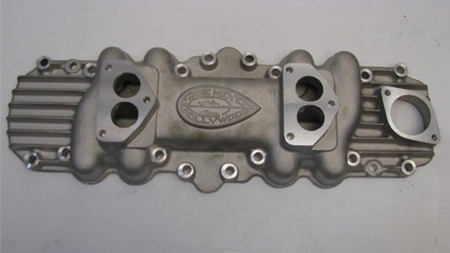
Fortunately post war airports didn’t have metal detectors and Reg was able to sneak one of Eddie’s manifolds back into the UK. The Allard boys soon appreciated the performance gain from the manifold and made quick work of making replicas for use on their performance Mercury 24-stud flatheads.
I must admit that it was a bit disappointing to learn that that Sydney basically ripped off someone else’s design (without even giving Meyer credit!). However, I don’t think it’s that big of a issue. Eddie Meyer couldn’t sell his manifolds in the UK and the odds of Allard selling a bunch of their knock-off manifolds in the US were pretty slim. Fortunately Eddie Meyer wrote a letter to Road & Track magazine (June, 1950), explaining the situation…although it was tough to tell whether he was proud or insulted that Allard had copied his design.
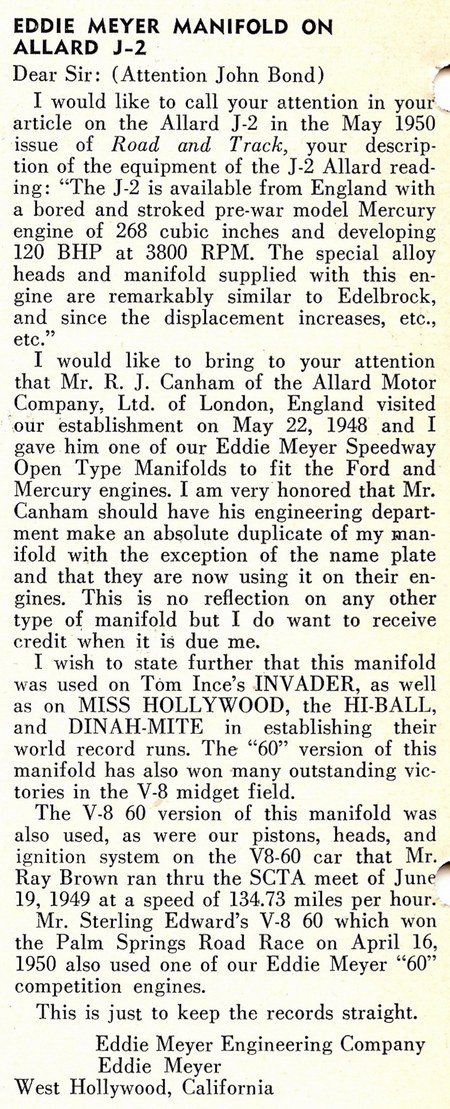
P.S.: If you know anything about or have any photos of Reg Canham’s USA M-type caravan trip, please click here to contact us!
While perusing the SCCA "Sports Car" newsletters that were kindly shared by Andy Picariello of the AOC, I came across this interesting story about the Dam Rally. Apparently Sydney decided to debut his fiberglass Palm Beach prototype with the entrants at one of the check points. Apparently the car caused at least a few entrants to be delayed. Click here or the photo above to read the story.
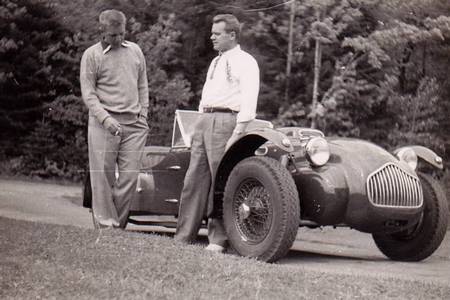
From Lindsey Parsons...
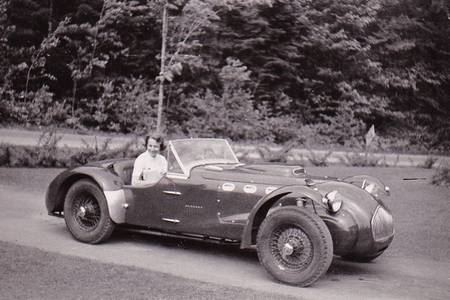
The report above is a vehicle test report from Zora Arkus Duntov regarding the Cadillac-Allard #952. Test car!? Allard!? Chevrolet!? It's no secret that the major car companies bought their competitors cars to test and dissect, but we think it's pretty cool that Chevrolet had an Allard as a test car. A few points of reference...this report was dated August 19, 1953 and the first Corvettes started rolling off the production line on June 30th of the same year. The first Corvette could hardly be called a true sports car, it was basically an underpowered sedan chassis wrapped in a sleek body. With the lack of comparable production sports cars from the competition, it makes sense that the bow tie would would want learn what made an Allard tick so they could make the Corvette better.
So what car did Chevrolet acquire? We know they had access to Fred Warner's J2X, but that was an outright race car. After checking the database, we found that Chevrolet purchased K3 3171 from Vauxhall Motors USA (Vauxhaul Motors was acquired by GM in 1925). It makes sense that they would use the K3 as a test mule...convertable body, V8 engine, sporting suspension. Although we don't learn much about the car from the report, we do learn that with a fairly stock automatic transmission, the car could hit 0-60 in 8 seconds flat...not bad! It also sounds like they have some plans to tune the car to see what else it could do.
Our records also indicate that Fred Warner ended up with the car and that it was raced. In case your curious, the car was light gray with a red interior and black top - and yes, the car still exists.
-Click here or the image above to download the pdf. Special thanks to Barry Burrell for sharing this document!
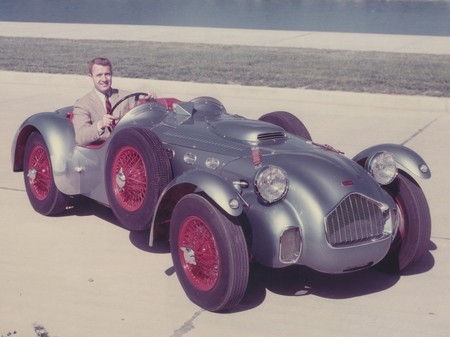
Few people realize the significant roll the Allard Motor Company had in General Motors. Sure many Allards shipped to the US were fitted with Cadillac engines, but they were also fitted with Chrysler, Lincoln, GMC, and of course Ford power. In 1952, Ed Cole was Chief Engineer at Chevrolet where he was tasked with developing the legendary small block V8. He was also friends with US General "Butch" Griswold, who was in command of the Third Air Force in the UK. Butch was a regular at the Allard plant and was good friends with Godfry Imhof. At that that time it was next to impossible to get anything imported into the UK, let alone a hot rodded American V8. That's where the saying, "It's not what you know, it's who you know," comes into play. Imhof wanted to upgrade his J2 and read about Fred Warner's J2X (pictured above) that had been equipped with a hot Cadillac engine that was serving as a Chevrolet test mule. So Imhof talked to Butch, and Butch talked to Cole. In the end, we don't know if Imhof ever got his engine, but if you read the letters below; you'll get to learn more about the "Warner" engine.
Click here to read the "Warner" letters (Acrobat pdf)
Special thanks to Barry Burrell for sharing these letters. Barry's dad Frank, was General Foreman of the Cadillac Experimental Garage. Frank also handled Fred Wackers Allard and was invited by Curtis LeMay to support the Allard team at the 1953 Le Mans.
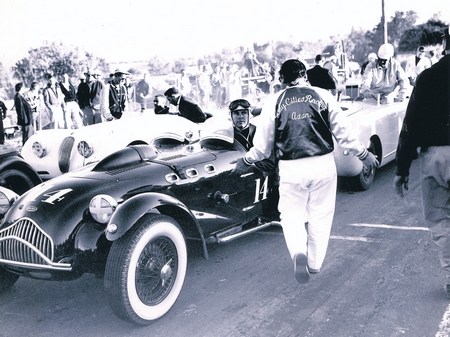
By Bill Pollack
Every time the number fourteen Allard raced it always started on the pole as the fastest qualifier. I don't think I really appreciated just how important that really was until years later. Thinking about it I'm not sure how I really accomplished that. It didn't seem to matter where we raced, the car was just scary fast compared to other cars in the field.
Being on the poll was always a little frightening because you have the entire field behind you, thousands and thousands of horsepower all screaming to go and if for some reason I stalled or some other stupid thing, it would be a terrible mess.
I know that when I was in front and the starter would give us the signal to start your engines there was always that awful moment when you thought God I hope the battery isn't dead. After the engine roared to life I've probably put the car in 1st gear at least 5 or 6 times just to make sure I was really in 1st gear. Sometimes I would actually let the clutch out just a little bit to make doubly sure that I was in number 1 slot. Of course, that was only the beginning.
My adrenal glands had probably been asleep for weeks or months since my last race and it was a rude awakening when the clutch came out and the car burst forward in a blinding explosion of speed. For some reason my vision immediately narrowed down to the front wheels and the road directly in front of me with little or no indication of what might be in my periphery. I don't think I was really aware of who was chasing me until at least the 2nd or 3rd corner had been negotiated without any serious mishap. Finally, I probably took a deep breath or let one out that I had been holding since the start of the race, and took a look to see who was back there. It was no surprise when it was usually Phil Hill.
I've never really had a chance to talk to other drivers about what it's like to sit in front and lead a race from pole to pole or from start to finish. The pressure which is enormous at the beginning of the race gradually diminishes as you complete each lap without serious actions bordering on dumb. There were moments when only you and no one else realizes that you had probably made a very small error and you simply told yourself don't even think about doing that again. It might have been experimenting with a slightly different line on a corner or changing the breakpoint for slow down by 5 or 10 feet. You quickly learn that the once you're in front this is not a good time or a place to experiment with how to go faster. After all, you're in front, what more do you want, all you have to do is stay there and everything should work out to your satisfaction.
People often commented to me about how difficult it must have been to drive the Allard, which they assumed was a bad handling car. The people who made those comments had never driven that car so I always took them with a grain of salt. But it wasn't until I drove several other Allards and then the black number 14 that I realize how much minute care and preparation went into that particular car. It was a number of adjustments and modifications that were made that resulted in the handling characteristics of that car being far superior to any other Allard I ever drove. Tom Carstens, in fact, had won a championship in midgets so he was well equipped to set up a car. Tom Carstens and Dave Fogg, his partner, were a team that was hard if not impossible to beat.
These days for a couple of hundred thousand dollars you can buy something from Italy, Germany or Great Britain that will go fast and is fun, but I will put up the Allard up against them. The Allard in terms of fun would be at the top.
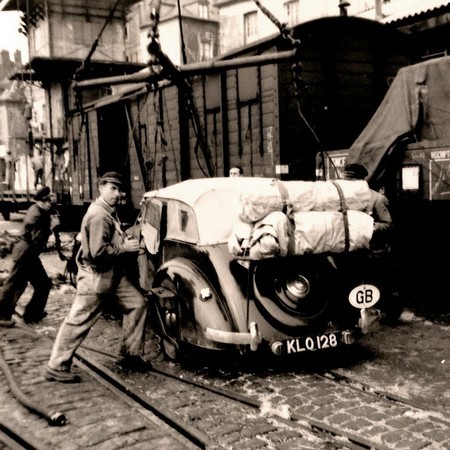
One of the best parts of hosting this site is getting random emails from people who were going through old family photos and they came across some relatives Allard. In this case, a gentleman asked is we knew who owned an Allard with registration #KLO 128. After checking the database, we confirmed the car was chassis L 852, but unfortunately we had no ownership history. According to our new freind, the car was originally owned by Mrs. Hilda Charlotte Mary Lee. Apparently Mrs. Lee had a thing for speed. According to a newspaper clipping, she once had an accident on the M1 in a Mercedes 300 SL with "lift-up seagull-type doors" which at the time was the fastest ever crash on this motorway being in excess of 100mph. These photos are from a trip Mrs. Lee, a family freind of our sender took with his uncle to the south of France. Enjoy!
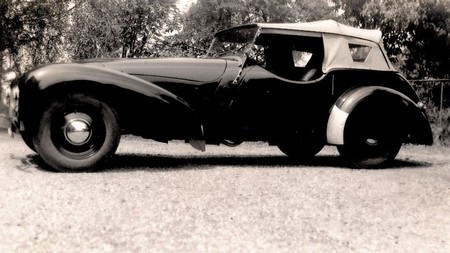
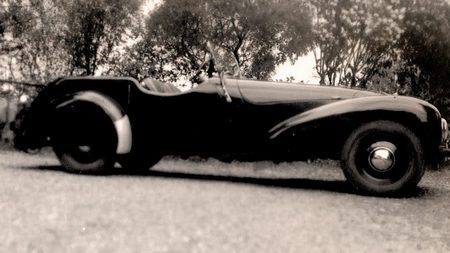
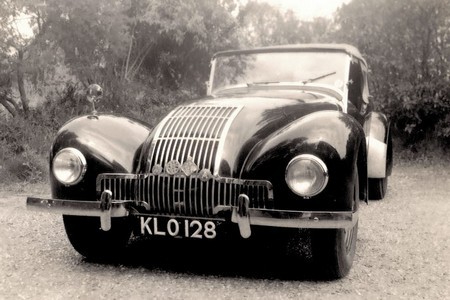
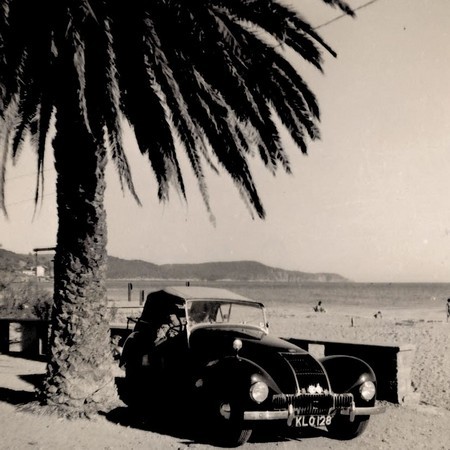
We are very pleased to present to you this exclusive document...The 1953 Le Mans Duntov Memo. To our knowledge it has never been seen in public. Back in January, we shared a map of the Le Mans course with Zora Akus Duntov's notes on the speed zones around the track and that it was a part of a larger report that helped set the performance transformation of the Corvette. You may also recall that Zora was almost fired by GM for racing at Le Mans for the Allard team...saved only by the grace of Ed Cole.
The report is fascinating in that he provides an analysis of the competition, along with a scathing review of the Allard JR's handling...while remaining steadfast that the Allard team had the best engines in the field (which happened to be Cadillac V8's...was Zora kissing up to the GM brass?).
Click here or the image below to view the complete memo. Special thanks to Allard owner Steve Schuler and his mole within GM for sharing this important memo.
We've been having a discussion on the Allard Yahoo Group recently about Erwin Goldschmidt and his J2, J2X, and JR. Here's a nice side shot of his J2X at the '52 Duryea Hill Climb.
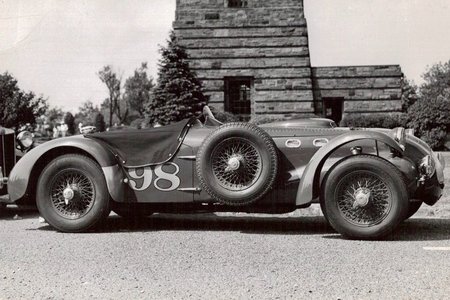
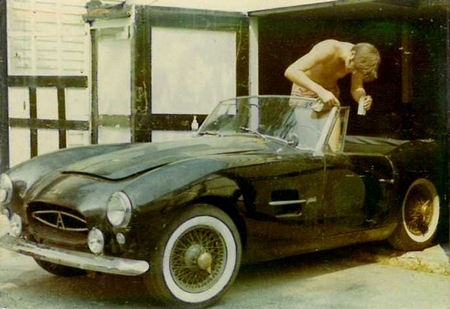
One of the things we love about running this web site is that it allows Allard owners from years past to connect with us. The other day, we recieved an email from Tom Coughlin who once owned this Palm Beach MkII, chassis 72/7104Z. He writes...
"It was probably 1968 when I was reading the Boston Globe classifieds and came across an ad for an Allard. Having attended races at Sebring, Opa-Locka, and Watkins Glen, etc., I was certainly familiar with the name Allard, but not the Palm Beach MKII. I really liked what I saw, and since it was a very rare thing for me to find a sports car that I had never seen before, I bought it. This was a left hand drive, black, Zephyr-powered driver. I have often read that they (Allards) had aluminum bodies, this one was steel. Although I was able to drive it home, the left rear shock mount had been knocked off of the rear axle making the ride downright poor. I never did get it properly sorted, so after eight years of ownership and very little use I decided to sell my wonderful Palm Beach MKII and have owned, driven and enjoyed Porsche 356’s ever since. I didn't take as many photos as I should have, but here are the only two that I have. Man, I was lean and mean at age 27!"
Chassis 7104Z was the second (and last) Zephyr powered Palm Beach MkII, although its currently powered by a Chevy small block. It was one of two delivered to the US (out of six).
Thanks Tom!
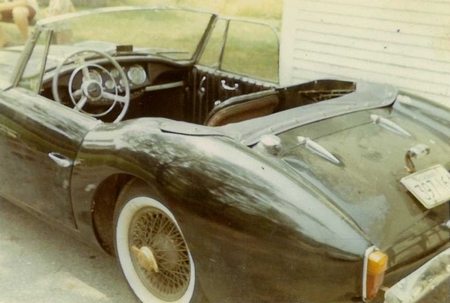
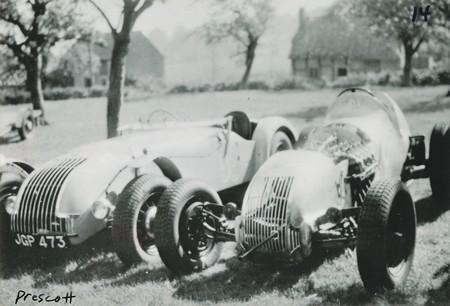 Around the same time that Sydney started work on the Steyr race car, he also started a new sports special that was registered as JGP 473. Although the Steyr took priority, JGP 473 was finished in June of 1947. Tom Lush writes about the special in his book, saying...
Around the same time that Sydney started work on the Steyr race car, he also started a new sports special that was registered as JGP 473. Although the Steyr took priority, JGP 473 was finished in June of 1947. Tom Lush writes about the special in his book, saying...
"Based on the J frame, with the same wheelbase and track, it was made much lighter by omiting much of the chassis-boxing and cross-bracing, and was lowered considerably by the use of flattened springs. The two-seater body consisted of an aluminum shell mounted over a light tubular framework, and as first constructed without doors, these being added later when regulations governing sports car racing made them compulsory.
Following Sydney's usual weight-savnig formula, the car was fitted with two lightweight seats and remained untrimmed and while in his possesion. The engine* which had been removed from HLF 601 when Leslie took it over had been stripped and rebuilt ready for installation in the new car as Sydney reckoned teh extra power obtained, even for a short time, amply compensated for the work involved in replacing the head gaskets."
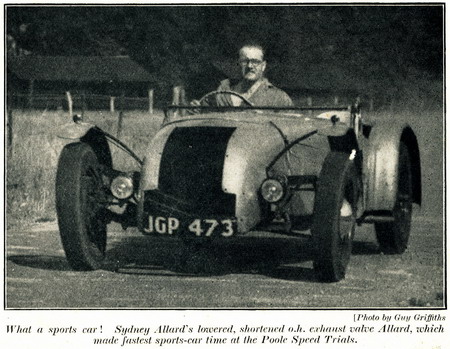
The car was very succesful breaking the sports car record at Prescott in 1948. Later, the car passed on to Leslie who continued to race the car with good results. At some point, the front end of the car must must have been damaged badly, because for For Sale photos of the car (via Chiltern Cars) show it with a completely different nose. The car was also fitted with a more liveable Mercury engine. We're not exactly sure what happened to the car, but it's thought to have been destroyed in a fire.
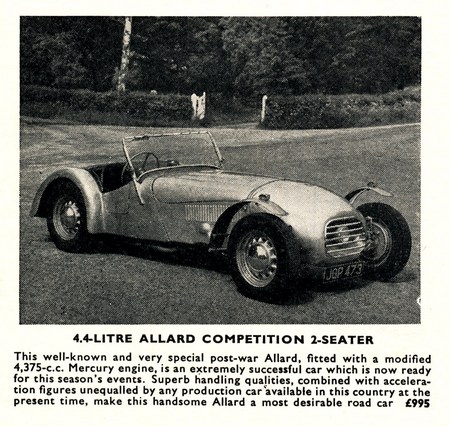
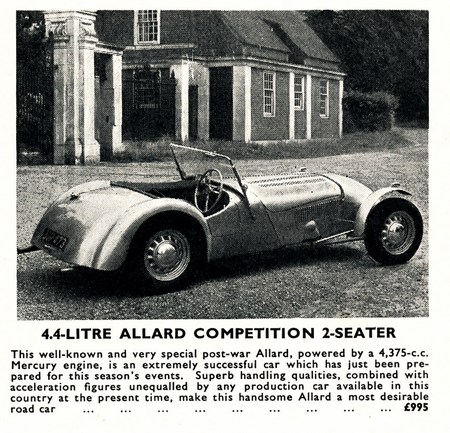 *The engine featured a crude set of cast-iron overhead valve heads from America that predated the Ardun head conversion. These heads were prone to blowing head gaskets on a weely basis. Does anyone know where these heads may have come from?
*The engine featured a crude set of cast-iron overhead valve heads from America that predated the Ardun head conversion. These heads were prone to blowing head gaskets on a weely basis. Does anyone know where these heads may have come from?
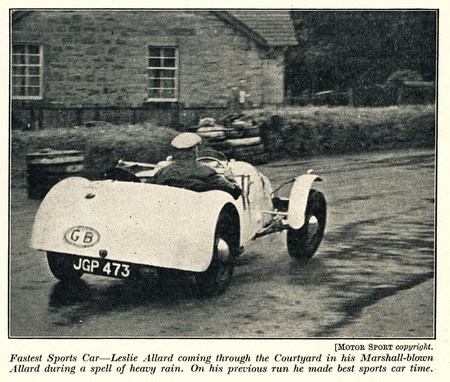

Our good friend Kerry Horan sent in the clipping above from the July 1967 issue of Road & Track. By digging through our chassis database, we believe the P1 is chassis 1720. Basically it's the only RHD P1 with black paint and a maroon interior that ever made it to America...that we know of at least. The JR is chassis #3407 that resides in the Mallya Collection. Our records indicate that the car shipped to the US in September 1962 after leaving the car of long time Allard enthusiast Rupert de Larrinaga.
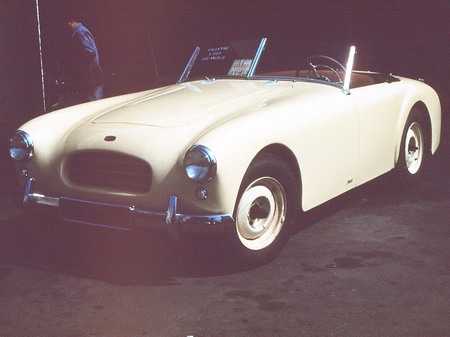
Here's a few more photos from the Moss files. The car in question is K3-3169, which was actually sold by Noel Kirk Motors to a Mr. William Valentine. What's it doing Al Moss' shop you might ask? Well, this was likely the first Allard sold by Noel Kirk and his shop didn't know how to install the engine (a Cadillac in this case), so they called up Al and asked if he would do it. Conveniently, Noel sent along a helper to assist with the project...and that was the last time Al did an engine installation for Noel. This second owner car is currently owned by Dr. Martin Allard (no relation).
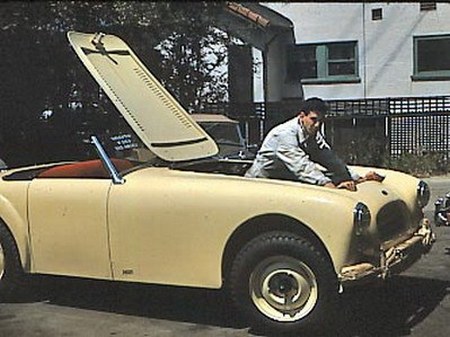
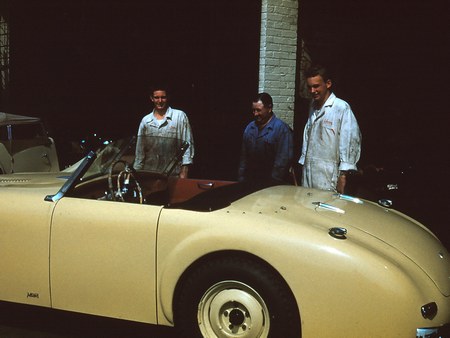
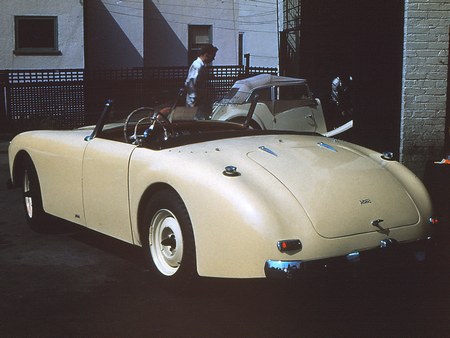
In the past we've highlighted a few "mystery cars" that were built on Allard chassis, but they featured a bespoke body on the rear. We knew very little about these cars until we came across this Allard advertisement the other day. It describes exactly what you received when your ordered your Allard chassis.

“Here is an exceptional opportunity. Immediate delivery can be given of a limited number of fully road tested Allard chassis, either left- or right-hand drive. Chassis specification includes: independent front wheel suspension, Ford V8 engine, Lockheed brakes, Dunlop tyres, front wings, cowl, grille, bumpers, spare wheel, full Lucas electrical equipment including lamps, horns, indicators, wind-screen wiper, instrument panel with all instruments and smith’s Side Jacking system. Coupe chassis wheel base 9’ 4” -£670.
In addition to the above two-seater 8’10” chassis and open four-seater 9’4” chassis at £670 include bonnet, bonnet sides and fittings, not mounted.
As the number of chassis available is limited, immediate application is advised either to the Allard Motor Company or your local accredited Agent.”
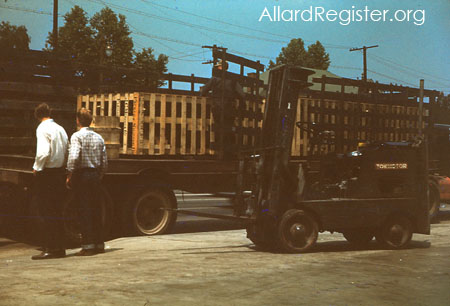
Along with the paper records that the late Al Moss donated to our archives, he also shared with us a number of rare color slides. The first batch of slides presented today give us a look at what it was like to take delivery of a new Allard in the US. These are the "skeleton" crates that all exported Allard cars were shipped in. Additionally, we get to see the joy of a new owner, in this case Basil Panzer receiving his new car. What an exciting day it must have been! The cars were delivered to Al's first shop, which he shared with Jack Gilchrist on 3200 W Olympic Blvd. Both cars were shipped from the Allard factory in late April of 1950. The black J2 of Bazil Panzer is chassis #1571 and the silver/grey L-type is chassis #1701 was ordered by Morgan Sinclair. We should note that the J2 was soon raced by young Phil Hill up Pikes Peak, more on that coming soon...
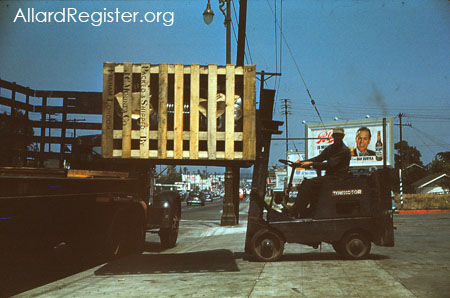
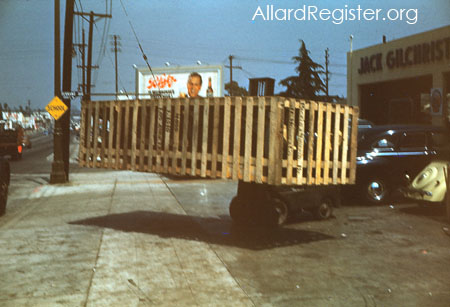

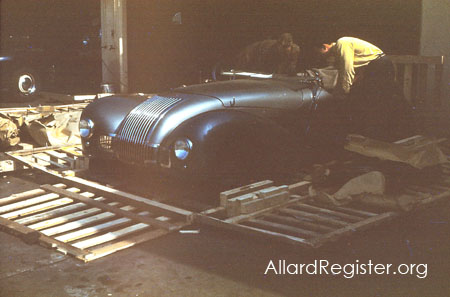
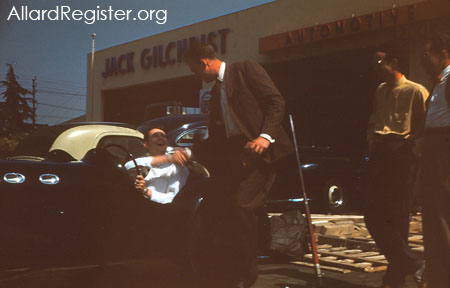
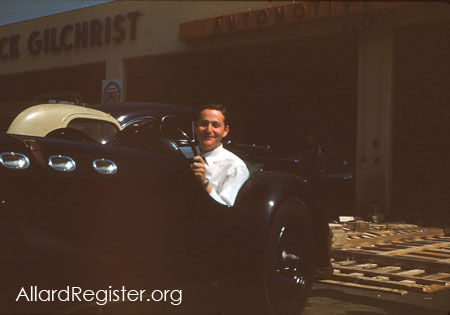

The photos you see here were sent to us by Bryan who owned this car back in the late 50's. He'd love to find out what happened to it...and we'd love to find out what chassis it is.
Bryan writes, "Here's a couple of photos of the old dear, known (naturally!) as Sabrina, although these days she could just as well be known as Dolly! She had a 3.5 litre flathead Ford V8, the weight of which made her a bit lazy where cornering was concerned but one didn’t worry too much. Acceleration out of corners, helped by the Ballamy front suspension, was scorching as you can imagine. In any case she had colossal braking power.
I bought her from a friend in about 1957 for £50 and ran her happily for about eighteen months until coming past Newmarket towards Six Mile Bottom the revs suddenly went sky high, without a noticeable increase in speed. Not surprising this. My co-driver told me we were doing fractionally over one ton at the time. I had her towed to my uncle’s farm at Hemingford. About three months later he told me he had sold her, minus any drive from the busted half-shaft, to an American airman from Basingbourne. This man was eager for her and paid me £150 for the privilege. I would surely say she didn’t owe me a penny then, but what would she be worth now?
Apart from this note I have no information about her. She was surely the strangest design of bodywork I have ever seen, almost but not quite an estate car and you could stuff an extra ordinary amount of luggage in through the tailgates. As her driving her, she was a joy and filled in the blank in my life just after I had had a bust at Paddock Bend and decided I wasn’t as good as Stirling and had better quit while I could.
As for her rudimentary silencers – what a lovely noise. I still adore the sound of a V-8!"
If you know anything about the car, please send us a note. This was likely one of the many M types that was sold without a body. It's like a hatchback shooting brake with a roll-top roof. Nice.

The image below is from Zora Arkus Duntov's technical report on the 1953 Le Mans race. This is the race that almost got Zora fired from GM, which means the Corvette as we know and love today...almost never was.
Reminder: The car that Zora raced to help create this report is up auction this Friday at RM in Scottsdale, lot #115.
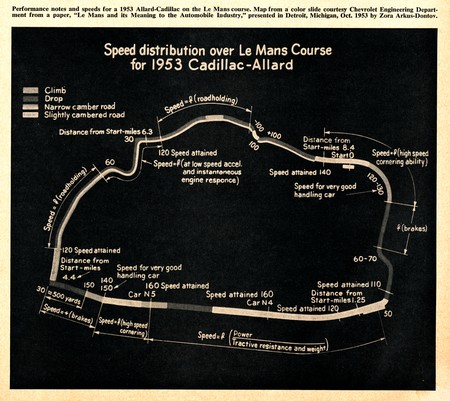
As with the previous letter, this one is also addressed to Mr. Cappy of the Britain Motor Co. It dates from June of 1948 and is probably typed on the thinnest paper I have ever handled. This letter is also the oldest Allard letter we have in our archives. Click here or the letter above to view as a pdf.
Sometimes you get lucky. The other day I won an Ebay auction for an Allard brochure that I didn't have yet. Along with the brochure were a few other brochures and some old letters. The package arrived today and as I sorted through the items I noticed that both letters were dated from 1948. Upon further inspection; one of the letters was from J.B. Ferguson of Fergus Motors in NYC to Allan Cappy of Britain Motor Co. in Rochester, NY. Mr. Ferguson writes about receiving a used K1 that was imported in 1947 and was modified with a Grancor "Hot Rod" engine with over 150 hp. Grancor was of course Andy Granatelli's (STP) shop that also imported a few Allards. What's interesting is that the K1 in question must be chassis 108, that was recently sold on Ebay. Click here or the photo above to view the pdf.